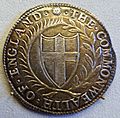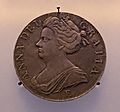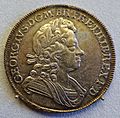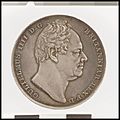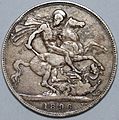Crown (British coin) facts for kids
| Great Britain (1707—1801) United Kingdom (1801—present) |
|
| Value |
|
|---|---|
| Diameter | 38 mm |
| Edge | Milled |
| Composition |
|
| Years of minting | 1707–1981 |
| Obverse | |
 |
|
| Design | Profile of the monarch (Victoria "jubilee head" design shown) |
| Designer | Joseph Boehm |
| Design date | 1887 |
| Reverse | |
 |
|
| Design | Various (St George design shown) |
| Designer | Benedetto Pistrucci |
| Design date | 1817 |
The British crown was a special coin in British money. It was worth a quarter of one pound, or five shillings. This was the same as 60 old pence. The crown coin was first made during the time of King Edward VI. It was part of the money used in the Kingdom of England.
Crowns were always heavy silver coins, weighing about one ounce. Over time, in the 1800s and 1900s, the crown stopped being an everyday coin. Instead, it became a coin mostly made for special events. Unlike in some parts of the British Empire, like Jamaica, the UK never replaced the crown with a five-shilling banknote.
After the British currency changed to decimal money in 1971, some "decimal" crowns were still made. At first, they were worth 25 new pence. However, since 1990, special commemorative crowns have been worth five pounds.
Contents
History of the Crown Coin
The crown coin started as the English silver crown. Many silver coins like it appeared in different countries from the 1500s. A famous example is the Spanish piece of eight. These coins were all similar in size and weight. They were about 38mm wide and weighed around 25g of fine silver. This made them easy to use for trade between countries. The Kingdom of England also made gold Crowns until the early reign of King Charles II.
The designs for all gold and silver coins for Queen Anne and King George I were created by John Croker. He was an engraver who came from Dresden in the Duchy of Saxony.
The British silver crown was always a large coin. From the 1800s, people did not use it much for daily shopping. However, new crowns were usually made in the year a new monarch was crowned. This happened from George IV up to Elizabeth II in 1953. The only exceptions were George V and Edward VIII.
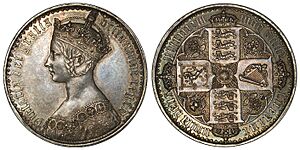
The King George V "wreath" crowns were made from 1927 to 1936. (The 1935 "rocking horse" crown was an exception, made for the King's Silver Jubilee). These "wreath" crowns showed a wreath design on the back. Very few of them were made. They were usually struck late in the year and meant as Christmas gifts. So, people often kept them instead of spending them. For example, only 932 coins were made in 1934.
Many later crown coins were mainly for special events. The 1951 crown was for the Festival of Britain. The 1953 crown celebrated the Coronation of Queen Elizabeth II. The 1960 crown marked the British Exhibition in New York. The 1965 crown showed Winston Churchill on its back. Nearly 20 million of these Churchill crowns were made. Even though they were meant for collectors, their large number and lack of precious metal mean they are not worth much today. Production of the Churchill crown started in October 1965 and ended in summer 1966.
The crown coin was sometimes called the dollar. But it's important not to confuse it with the British trade dollar. That coin was used in Asian countries.
In 2014, a new record price was set for a milled silver crown. This unique coin was a pattern made by engraver Thomas Simon in 1663. It was called the "Reddite Crown." It was shown to Charles II as a new crown coin. But the King chose a different design instead. Auctioneers Spink & Son in London sold this coin for £396,000 in March 2014.
All crown coins made from 1818 onwards are still legal money today. Their official value is 25 pence.
Decimal Crown Coins
After the currency became decimal on February 15, 1971, the 25-pence coin was introduced. It replaced the crown as a special commemorative coin. These coins were legal money and many were made.
More special crowns continued to be minted. At first, they were worth twenty-five pence. They did not show their value on the coin. From 1990, the value of new crown coins was raised to five pounds.
| Preceded by English crown |
Crown 1707–1965 |
Succeeded by Twenty–five pence |
Understanding Crown Values
The official value of the crown coin stayed at five shillings from 1544 to 1965. However, for most of this time, the coin did not have its value printed on it. From 1927 to 1939, the word "CROWN" appeared. From 1951 to 1960, this changed to "FIVE SHILLINGS." Coins made since 1818 are still legal money, worth 25 pence.
Most "normal" crowns made since 1951 are made of cupro-nickel. But special proof versions are made for collectors. These are sold as gifts and are often made of silver, gold, or sometimes platinum.
Today, gold £5 crowns are made. This means there are two types of five-pound gold coins. One is the crown, and the other is called a "quintuple sovereign."
In the world of coin collecting, "crown-sized" means a large silver or cupro-nickel coin. These coins are usually about 40 mm wide. Many Commonwealth countries still make crown-sized coins for collectors.
New Zealand's original fifty-cent coins and Australia's fifty-cent coins (which used to be round) were smaller than the standard silver crown coins. Even though they were worth five shillings in the old money system, they were actually similar in size to the old half crown. The half crown was worth two shillings and sixpence.
What are Crowns Made Of?
For silver crowns, the silver quality followed a very old standard. This standard was set in the 1100s by King Henry II. It was the Sterling Silver standard, which means 92.5% silver and 7.5% copper. This mix made the coins stronger and last longer. It also helped stop people from "clipping" the edges of coins to steal silver. This practice was further stopped by adding the milled (ridged) edge we see on coins today.
In 1920, the amount of silver in all British coins was reduced. It went from 92.5% to 50%. Part of the rest was manganese. This made the coins turn a very dark color after being used for a while. Silver was completely removed in 1947. Coins were then made of cupro-nickel. However, special proof coins for collectors still used the old 92.5% silver mix.
Since the Great Recoinage of 1816, a crown coin has usually been about 38.61 millimetres (1.520 in) wide. It has weighed 28.276 grams (which is 10⁄11 of a troy ounce).
Modern Crown Minting Numbers
| Monarch | Year | Number minted | Detail | Composition* |
|---|---|---|---|---|
| Edward VII | As 5/- (60d - quarter sovereign) | |||
| 1902 | 256,020 | Coronation | 0.925 silver | |
| George V | 1927 | 15,030 (proof only) | 'Wreath' Crown | 0.500 silver |
| 1928 | 9,034 | 'Wreath' Crown | 0.500 silver | |
| 1929 | 4,994 | 'Wreath' Crown | 0.500 silver | |
| 1930 | 4,847 | 'Wreath' Crown | 0.500 silver | |
| 1931 | 4,056 | 'Wreath' Crown | 0.500 silver | |
| 1932 | 2,395 | 'Wreath' Crown | 0.500 silver | |
| 1933 | 7,132 | 'Wreath' Crown | 0.500 silver | |
| 1934 | 932 | 'Wreath' Crown | 0.500 silver | |
| 1935 | 714,769 | George V and Queen Mary Silver Jubilee | 0.500 silver | |
| 1936 | 2,473 | 'Wreath' Crown | 0.500 silver | |
| George VI | 1937 | 418,699 | Coronation | 0.500 silver |
| 1951 | 1,983,540 | Festival of Britain | Cu/Ni | |
| Elizabeth II | 1953 | 5,962,621 | Coronation | Cu/Ni |
| 1960 | 1,024,038 | British Exhibition in New York | Cu/Ni | |
| 1965 | 19,640,000 | Death of Sir Winston Churchill | Cu/Ni | |
| As 25p (quarter sovereign) | ||||
| 1972 | 7,452,100 | Queen Elizabeth II 25th Wedding Anniversary | Cu/Ni | |
| 1977 | 37,061,160 | Queen Elizabeth II Silver Jubilee | Cu/Ni | |
| 1980 | 9,306,000 | Queen Mother 80th Birthday | Cu/Ni | |
| 1981 | 26,773,600 | Charles and Diana Wedding | Cu/Ni | |
| For crowns minted from 1990, which have a value of £5, see here. | ||||
- The materials listed are for the regular coins used by the public. Special proof versions are still made in Sterling silver.
Images for kids






